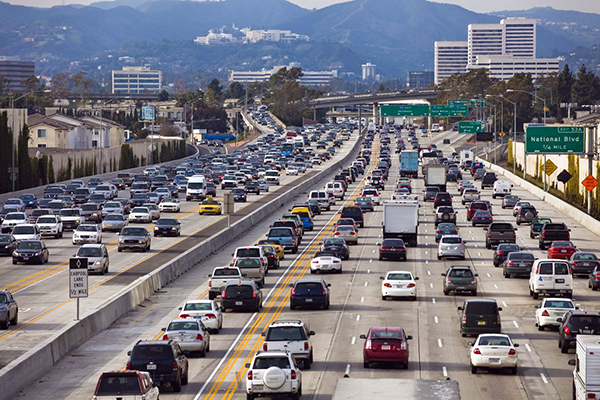A .gov website belongs to an official government organization in the United States.
A lock () or https:// means you've safely connected to the .gov website. Share sensitive information only on official, secure websites.
23 November 2021
adapted from the story by the American Chemical Society (ACS)

By disrupting normal societal activities, such as driving, COVID-19 lockdowns afforded a unique opportunity to study their impacts on the environment. Researchers now report in Environmental Science & Technology Letters that satellite data from before and during the spring 2020 lockdown in Los Angeles shows that vehicles, rather than agriculture, are the main source of urban air-borne ammonia (NH3), which forms small particles that contribute to air pollution and harm human health.
When emitted into the atmosphere, NH3 is converted into tiny particles of inorganic compounds, including ammonium sulfate and ammonium nitrate. On a national or global scale, most NH3 pollution comes from agricultural sources, such as livestock manure. But vehicles also contribute to the problem because their catalytic converters or selective catalytic reduction systems – which are designed to reduce emissions of nitrogen oxide (NOx) pollutants including NO2 – have the undesirable side-effect of producing ammonia emissions. In cities, it's been hard to tell whether agriculture or traffic emits more NH3, and the default assumption has been that agriculture is the greater culprit, despite some labor-intensive measurement studies that suggested otherwise in a few cities. CSL co-authors Brian McDonald and Colin Harkins and colleagues wanted to see if satellite data could be used to answer this question for the first time from space, since such an approach in principle could be applied more broadly to urban areas throughout the world.
The researchers focused on western Los Angeles, where previous on-the-ground measurements found that vehicle emissions of NH3 were being underestimated. The team analyzed satellite readings of NH3, as well as NO2. Because the main source of NO2 in the region is on-road transportation, the compound can serve as a proxy for changes in traffic volume and an indicator of vehicular as opposed to agricultural ammonia emissions. The team correlated concentrations of the two pollutants, and also took meteorological effects into account, to calculate the amount of ammonia emissions that can be traced to vehicles. They found that vehicles accounted for 60% to 84% of total NH3 emissions at this urban location, consistent with estimates provided by modeling, but substantially higher than the 13% to 22% share estimated from prior state and federal inventories. The researchers say their findings suggest the health impact of vehicle-related ammonia may rival that of NOx, yet it has been largely under-recognized and uncontrolled.
Cao, H., D.K. Henze, K. Cady-Pereira, B.C. McDonald, C. Harkins, K. Sun, K.W. Bowman, T.-M. Fu, and M.O. Nawaz, COVID-19 lockdowns afford the first satellite-based confirmation that vehicles are an under-recognized source of urban NH3 pollution in Los Angeles, Environmental Science & Technology Letters, doi:10.1021/acs.estlett.1c00730, 2021.
In situ measurements have suggested vehicle emissions may dominate agricultural sources of NH3 in many cities, which is alarming given the potential for urban NH3 to significantly increase human exposure to ambient particulate matter. However, confirmation of the prevalence of vehicle NH3 throughout a city has been challenging because of mixing with agricultural sources, and the latter are thus routinely assumed to dominate.
Here we report vehicle NH3 emissions based on TROPOMI NO2 and CrIS NH3 (0.152 kg s−1) that are consistent with a model-based estimate (0.178 kg s−1) and show that COVID-19 lockdowns provide a unique opportunity for making the first satellite-based constraints on vehicle NH3 emissions for an entire urban region (western Los Angeles), which we find make up 60−95% of total NH3 emissions, substantially higher than the values of 13−22% in state and national inventories. This provides a new means of constraining a component of transportation emissions whose impacts may rival those of NOx yet which has been largely under-recognized and uncontrolled.